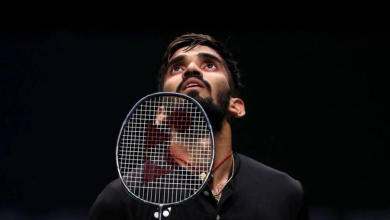India versus South Africa: In a lost cause, India’s T20 batting formula for the future emerges

It was only the fifth ball that Ruturaj Gaikwad had faced on a surface that abetted lateral movement with the new ball. Just two balls ago had Kagiso Rabada drawn a hideous grope from him with a ball that held a shade after pitching. The South African talisman traded a stare that could have scorched his eyes, had he gazed back at him.
The ball after—the next ball was a non-event flick—Gaikwad shimmied down the surface as though he was countenancing a muck-as-any club bowler, backed away and tried to smear him over the extra cover.
He missed—Rabada was shrewd to pick the cues his feet betrayed—and looked witless. The stroke defied logic, even in the helter-skelter world of T20s. The match was just two overs old, the first over was a 13-run bounty, he was getting his eye in, and he was supposed to be a batsman who gets his eye in before stroking those non-violent strokes.
But even in his failure, and even in India’s incapacity to close out the game, there shone the bright lights of a brighter T20 future. What mattered was the philosophy, the approach, aggression, and the intensity, even if they stumbled and stuttered at times, even if there was mayhem and madness at times, and even if they lost the match. Perhaps, the approach needs more polishing and fine-tuning, more cutting edge, before it becomes a fully evolved world-beating blueprint.Best of Express PremiumPremiumPremiumPremiumPremium
But for what it was on Thursday, it stood as a metaphor for India’s quest to alter their outdated, inhibited approach in the T20s, the chief instigator of the group stages exit in the last T20 World Cup.
India’s captain Rishabh Pant, left, shakes hands with South Africa’s David Miller to congratulate him on their win in the first T20I cricket match between India and South Africa in New Delhi. (AP Photo)
The tweaked approach did not suffice, as South Africa had the tools to hunt down the target, but one day it could be successful. The promise of more successful days was the promise they made on Thursday.
The idea was to shellack as many runs as possible—T20 cricket has stripped cricket to its fundamentals. And so Gaikwad and Ishan Kishan went about their big-hitting business, unhinged failures, edges, the ball beating the bat, scowls and stares from the bowlers and fielders. The next over, Andre Nortje darted a rapid, sharp bouncer into Gaikwad’s neck. Gaikwad weaved away a touch from the line of the ball and hooked it.
He mimed the stroke—it did not matter—but the top edge was chunky enough to soar over the ropes. The pair of openers rode an incongruous amount of fortune but remained unshackled. In their single-minded devotion to accelerate, they did not spare any bowler—be it Rabada or Nortje, Tabraiz Shamsi or Dwayne Pretorius.
India’s Ruturaj Gaikwad hits a six during the first Twenty20 cricket match between India and South Africa in New Delhi. (AP Photo/Altaf Qadri)
It was a high-octane, high tempo, high-risk approach. Every batsman, every ball, their sole quest seemed to be hitting every ball out of the Kotla, into the cramped alleys of Old Delhi, its charming neighbourhood. Followed moments of breathless, often spellbinding batting. From the sixth to the 11th over, they plundered 76 runs in six overs, of which only one had fielder restriction. They were not merely content with the runs they had put on the board, they wanted more.
🚨 Limited Time Offer | Express Premium with ad-lite for just Rs 2/ day 👉🏽 Click here to subscribe 🚨
Kishan had slaughtered Maharaj for 20 runs in the first five balls, but he wanted more. Greed ushered in his downfall, but in the world of the gluttonous, better be greedy. Similarly, Pretorius had just consumed Shreyas Iyer, but Rishabh Pant hammered him for 16 runs in the last four balls. Earlier, Shreyas showed he was undaunted the propensity to get out to wr spinners and smoked Shamsi for a brace of sixes in an over. Then descended Hardik Pandya, who cuffed 31 off 12 balls.
None of these batsmen looked to just hang around and let the partner, perhaps better schooled in launching the missile strikes, pack the big punches. Everyone seemed in a mood to unfurl the knockout blow. The worst strike rate (notwithstanding Karthik who faced just a couple of balls), was Shreyas’s—and that was 133. Pandya’s was 259, Pant struck at 181; Kishan 158, and Gaikwad 153. None of them wasted too many balls for their first boundaries either—Gaikwad took eight balls, but Kishan just 5, Shreyas 3, Pandya 4 and Pant 6.
Strangely, as many as 45 balls were not scored off. That probably conveys a story too—in the bargain for boundaries, they traded more dot balls than usual. The successful West Indies team of the 2016 World Cup embossed a similar pattern. As many as 14 sixes and 16 fours were struck, and there were only three overs without a boundary being hit.
The most perceptible difference was in how they approached the middle-overs (overs 7 to 16), usually the quietest phase of a T20 innings, when batsmen wait for loose balls and motor on with a stream of singles to build the platform for the death overs. But India hared along in this phase—as if the death overs had begun from the seventh over. The result was a carnage of boundaries—99 runs were racked up in 9 overs. The tempo heightened towards the end, flowing into an irresible Pandya-strung crescendo. India lost the game, but they could head back in the grim satisfaction that their formula was faultless.







